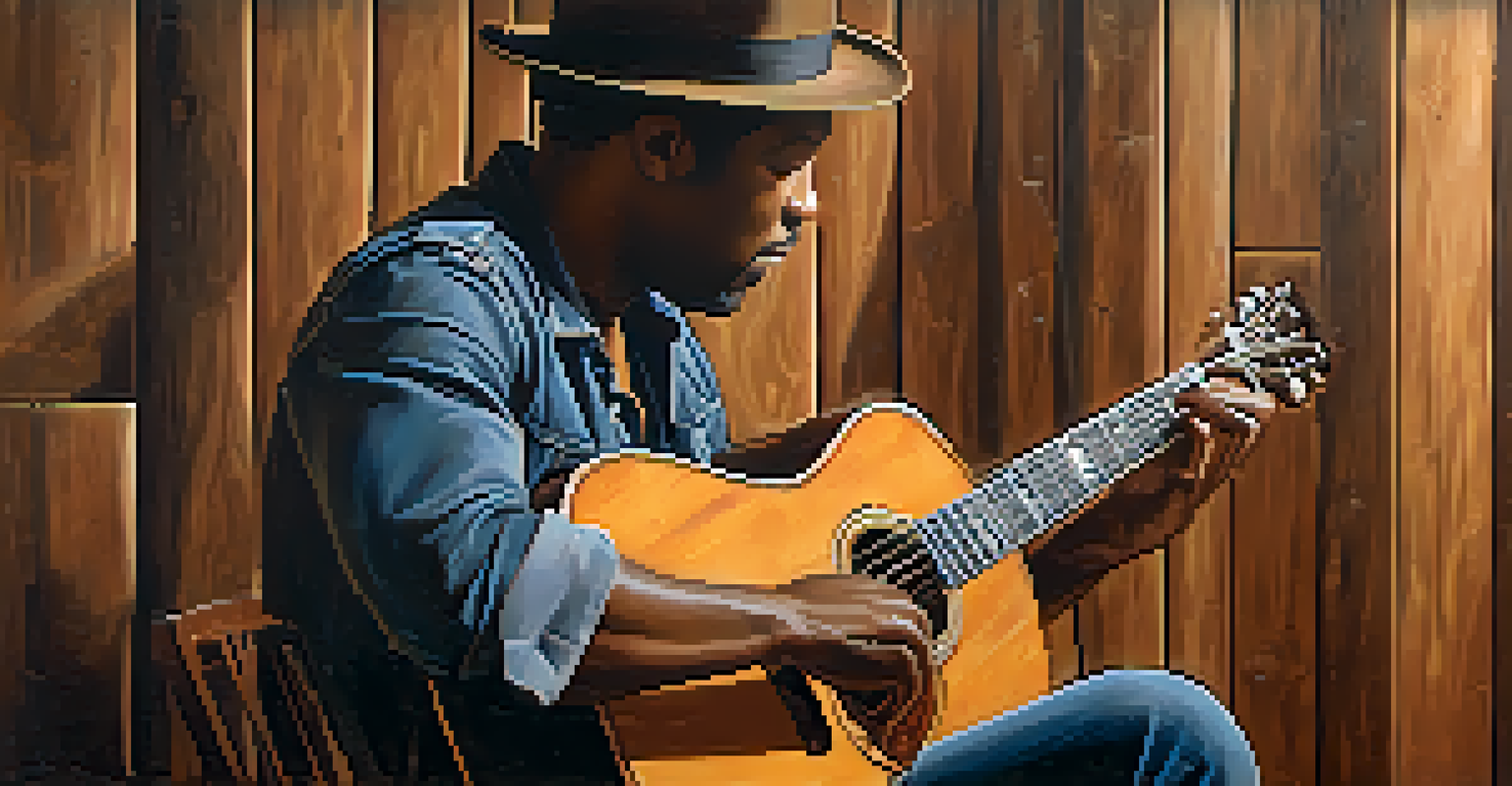Blues Guitar Techniques: Analyzing Iconic Songs

Understanding the Basics of Blues Guitar
Before diving into specific songs, it’s crucial to grasp the fundamentals of blues guitar. The genre typically revolves around a 12-bar blues structure, which serves as the backbone for countless tracks. This simple yet powerful framework allows for improvisation and expression, making it a favorite among guitarists. By familiarizing yourself with the basic chords and progressions, you'll be better prepared to tackle iconic songs.
The blues is a simple music, but it can be played in a thousand ways.
In addition to the chord progressions, understanding the blues scale is key. This scale consists of the root, minor third, fourth, diminished fifth, fifth, and minor seventh, and it provides the foundation for many solos and riffs. Practicing this scale will enhance your ability to improvise and create your unique sound. Think of it as the palette for your musical painting—without the right colors, your masterpiece may fall flat.
Finally, listen and absorb! The blues is deeply rooted in emotion, and each note carries a story. Take time to listen to greats like B.B. King and Muddy Waters to feel how they express themselves through their guitar. This emotional connection will not only improve your technique but also help you develop your style.
The Power of Bending Notes: A Signature Technique
Bending notes is one of the most recognizable techniques in blues guitar. It adds expressiveness to your playing, allowing you to mimic the human voice's nuances. By pushing a note up to a higher pitch while fretting, you can create a sound that resonates with emotion. This technique is particularly effective in solos, where the goal is to draw the listener in.

For example, listen to the opening of 'The Thrill is Gone' by B.B. King. His use of bending not only showcases his technical skill but also conveys a sense of longing. Try practicing bends on the strings, focusing on achieving a smooth transition to the higher pitch. Start with half-step bends, then gradually add more dramatic bends to really capture that bluesy feel.
Fundamentals of Blues Guitar
Understanding the 12-bar blues structure and blues scale is essential for mastering blues guitar.
Incorporating bends into your playing can elevate your solos from ordinary to captivating. Remember, it’s not just about hitting the right notes; it’s about telling a story. Each bend can express joy, sorrow, or anything in between, so make sure to play with intention and feeling.
Mastering the Art of Slide Guitar
Slide guitar is another iconic technique that defines the blues sound. This method involves using a slide—often made of glass or metal—on the strings to create smooth glissandos. The result is a hauntingly beautiful sound that can evoke deep emotions. Many legendary blues artists, like Elmore James and Bonnie Raitt, have mastered this technique, giving their music a unique character.
It's not the guitar you play, it's how you play it.
To get started with slide guitar, it’s essential to maintain proper finger positioning. Place the slide on your ring or middle finger and ensure that it’s straight over the fret. This setup allows for clean notes without buzzing. Practice sliding between notes to develop your control and precision. Think of it as gliding across a smooth surface; a little practice goes a long way.
As you become more comfortable with the slide, try incorporating it into classic blues songs like 'Dust My Broom.' This will not only enhance your technique but also deepen your appreciation for the genre. Remember, slide guitar is all about feeling, so let your emotions guide your playing.
Exploring Fingerpicking Techniques in Blues
Fingerpicking is a fantastic technique that adds depth and texture to your blues guitar playing. Instead of using a pick, you’ll pluck the strings directly with your fingers. This method allows for a more intricate sound and can be heard in many classic blues tracks, such as 'Black Mountain Blues' by Mississippi John Hurt. It’s like playing a piano—each finger contributes to the melody and harmony.
To start fingerpicking, practice using your thumb for the bass notes and your index and middle fingers for the melody. This approach creates a rich, full sound that can really capture the essence of the blues. Begin slowly, focusing on coordination before increasing your speed. It’s all about building a solid foundation, just like learning to walk before you run.
Expressive Techniques in Blues
Techniques like bending notes and slide guitar enhance emotional expression in blues playing.
As you grow more comfortable, try incorporating fingerpicking into your own improvisations. Feel free to experiment with different patterns and rhythms. You'll find that this technique not only enhances your playing but also adds your unique flavor to traditional blues songs.
The Importance of Rhythm and Timing in Blues
Rhythm and timing are the heartbeats of blues music. A strong sense of rhythm allows guitarists to connect with other musicians and create a cohesive sound. Unlike many other genres, blues often embraces a laid-back, swung feel that gives it a unique groove. This is why it’s essential to internalize the rhythm as you learn to play iconic songs.
For example, consider the famous track 'Sweet Home Chicago' by Robert Johnson. The rhythm carries the song, making it instantly recognizable. To master this aspect, practice playing along with a metronome or backing track. Start slow, ensuring that your notes align perfectly with the beat before gradually increasing the tempo.
Additionally, don’t be afraid to improvise with your timing. Blues allows for a lot of flexibility, and playing slightly behind or ahead of the beat can create tension and excitement. This playful approach to rhythm is what makes blues music so engaging, so let your personality shine through in your playing.
Utilizing Chord Progressions in Iconic Blues Songs
Chord progressions form the backbone of many iconic blues songs, and understanding them can greatly enhance your playing. The typical 12-bar blues progression consists of the I, IV, and V chords, creating a familiar yet versatile framework. Songs like 'Hoochie Coochie Man' by Muddy Waters exemplify how these simple chords can lead to powerful music. It’s like having a solid foundation for a house—you need it to build something great.
To get comfortable with these progressions, practice playing them in different keys. Experiment with variations by adding seventh chords or incorporating passing chords to create movement. This exploration will not only improve your technical skills but also inspire your creativity as you compose your own blues pieces.
Improvisation and Rhythm Mastery
Improvisation and a strong sense of rhythm are crucial for creating a unique and engaging blues sound.
As you become more confident, try applying these progressions to your favorite songs. Play along and notice how the chords shape the song's emotion. By mastering these progressions, you’ll be well on your way to becoming a proficient blues guitarist.
Incorporating Improvisation into Your Blues Playing
Improvisation is a thrilling aspect of blues guitar that allows you to express your individuality. Unlike classical music, where everything is meticulously planned, blues encourages spontaneity. Listening to legends like Jimi Hendrix or Stevie Ray Vaughan demonstrates how improvisation can elevate a song, adding unexpected twists and turns. Think of it as a conversation; you respond to the music in real-time, making each performance unique.
To get started, practice improvising over the 12-bar blues progression using the blues scale we discussed earlier. Focus on phrasing and dynamics; the way you play a note can change its impact. Consider incorporating techniques like bends and slides to add emotional depth to your solos. It’s about creating a narrative that resonates with your audience.

Additionally, don’t shy away from experimenting with different rhythms and patterns while improvising. The blues is all about feeling, so trust your instincts as you play. Over time, you’ll develop your voice and style, making your improvisations truly your own.
Learning from the Masters: Key Songs to Study
Studying iconic blues tracks is one of the best ways to enhance your skills. Songs like 'Crossroad Blues' by Robert Johnson and 'Pride and Joy' by Stevie Ray Vaughan showcase various techniques discussed throughout this article. By breaking down these tracks, you can gain insights into how the masters approach rhythm, melody, and improvisation. It’s like learning from a mentor—each note carries a lesson.
Start by choosing a few songs that resonate with you and focus on learning them note for note. Pay attention to the techniques used, such as bends, slides, and fingerpicking, and try to replicate them in your playing. As you dissect these songs, you’ll uncover the nuances that make them compelling and learn to incorporate those elements into your style.
Finally, don’t forget to enjoy the process! Learning from the masters is not just about technical skill; it’s about connecting with the music on a deeper level. Let your passion for blues guide your journey, and you’ll find that each song you study enriches your musical understanding.